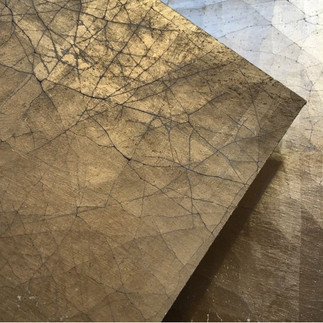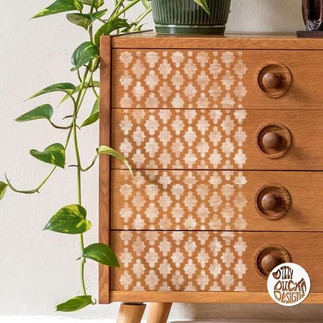Miss Old Days
- Arisa Chattasa

- Jun 30, 2023
- 7 min read

Refresh Look by Faux Finish
It is bright side of keeping old furniture and decorative items as classic or vintage style instead of putting in the garbage and/or destroying them. Owners sometimes fix broken parts for prolong useful life, some renewed by painting with remaining vintage style for some reasons such as a combination of personal, aesthetic, sentimental, and practical considerations. It allows people to create spaces that are unique, meaningful, and reflective of their individual tastes and values. People think of nostalgia and sentimental value. Old furniture and decorative items often hold sentimental value for people, reminding them of their past, family members, or cherished memories. Keeping these items allows them to maintain a connection to their personal history and heritage. People perceive an aesthetics and charm. Classic or vintage furniture and decorative objects often have a unique charm and character that may not be easily replicated by modern pieces. The craftsmanship, design, and materials of older items can be admired for their authenticity and timeless appeal. Importantly, durability and quality are focused. Many older furniture pieces were built to last, using high-quality materials and craftsmanship. As a result, they may be more durable and sturdier compared to some modern, mass-produced items. Also, cost – effectiveness is owners’ concern. In some cases, vintage or classic furniture can be more affordable than brand - new pieces of similar quality range. People may choose to invest in older items that have stood the test of time instead of buying expensive modern alternatives. Historical and cultural significance is one of reasons. Some older furniture and decorative items hold historical or cultural significance. People may keep and preserve these items as a way to honor and appreciate the past. Besides, interest in collecting should not be overlooked. For some individuals, collecting vintage or antique furniture and decor is a hobby or passion. They enjoy searching for, acquiring, and restoring these items, creating a collection that reflects their interests and tastes. Moreover, interior design preferences are discussed here. Some people simply prefer the classic or vintage style in their interior design over modern aesthetics. The timeless and elegant look of older pieces complements certain design themes and architectural styles. Additionally, unique and one – of – a - kind pieces are obvious. Vintage and antique furniture often come in unique designs and styles that cannot be found in modern stores. Owning such one-of-a-kind pieces allows individuals to express their individuality and taste in home decor. Lastly, sustainability and environmental concerns are focused by Tanyarin to strengthen this concept and convince owners to keep and use old furniture and decorative items align with sustainable practices and reduce the demand for new products. It helps reduce waste and the environmental impact associated with the manufacturing and transportation of new items. There are several methods of old furniture renewal such as fixing broken parts, applying Gold leaves as Gilding process Gilding always Fascinating (tanyarindecoration.com) and coating a special paint such as glitter and pearlescent paint Refreshing Items to Reuse (tanyarindecoration.com). For pearl paint itself, more details are https://www.tanyarindecoration.com/perlata. Now, it's time of faux finish to refresh old ones.
What is “ Faux Finish ”?
Faux finishes can be an excellent way to refresh old furniture and give them a new look. Faux finishes are decorative painting techniques that Tanyarin replicates the appearance of different materials or textures. Tanyarin creates the illusion of wood grain, marble, stone, metallic finishes, and many other effects. Here are a few popular faux finish techniques :
1. Woodgraining
This technique mimics the appearance of different wood species. It involves layering paint colors and using specialized brushes or tools to create grain patterns and textures.
2. Marbleizing
Marbleizing gives furniture the elegant look of marble. It involves layering paint colors and using brushes, sponges, or other tools to create the characteristic veins and swirls found in marble.
3. Decoupage
Decoupage is a decorative technique that involves the application of cut-out paper or fabric designs to various surfaces, such as furniture, boxes, trays, and other objects together with Jo Sonja's paint. The word "decoupage" originates from the French word "decouper," which means "to cut out." The process of decoupage typically involves the following steps :
3.1. Surface preparation > The surface to be decorated is cleaned, sanded if necessary, and primed with a base coat of paint or a suitable primer. This provides a smooth and even surface for the decoupage design.
3.2. Cut - outs > Designs or motifs are carefully cut out from paper, fabric, or other thin materials. These cut-outs can be sourced from various materials such as printed napkins, decorative paper, magazines, wrapping paper, or even fabric scraps.
3.3. Adhesive application > A decoupage adhesive or medium, often a glue specifically formulated for decoupage, called "Jo Sonja Tannin Sealer" is applied to the surface where the cut - outs will be placed. The adhesive is typically brushed onto the surface, ensuring even coverage.
3.4. Placement and smoothing > The cut - out designs are carefully placed onto the adhesive-coated surface. It's important to smooth out any air bubbles or wrinkles using a soft brush or a clean cloth, working from the center outward.
3.5. Sealant application > Once the cut - outs are in place and the adhesive has dried, multiple layers of a sealant or varnish are applied over the entire surface. This helps protect the design, create a smooth finish, and enhance durability. Various types of sealants can be used, such as decoupage varnishes, Mod Podge, or even water-based polyurethane.
3.6. Finishing touches > After the sealant has dried, additional decorative elements, such as paints, glitters, or additional layers of decoupage, can be applied to enhance the design further. These optional steps allow for more customization and creativity.
Cr. Pics from Pinterest
4. Rustic Mood
Creating a rust or patina effect is indeed a popular faux finish technique used to give surfaces an aged, weathered appearance. This technique is often employed to mimic the natural corrosion and oxidation processes that occur over time on metal surfaces. To achieve a rust or patina effect, various methods can be used, including the following :
Rust Effect : This technique aims to replicate the appearance of rusty metal. It typically involves a multi - step process, starting with a base coat of paint in a desired color, often a reddish - brown or orange tone resembling rust. Once the base coat is dry, additional layers of paint or specialized products, such as rusting agents or iron oxide solutions, are applied strategically. These products interact with the underlying layers, creating the appearance of rusted areas, drips, and textures.
Patina Effect : Patina refers to the surface coloration that develops on metals over time due to exposure to elements such as air, moisture, and chemicals. To achieve a patina effect, various techniques can be employed, depending on the desired outcome. This may involve layering paint colors, applying glazes or washes in specific shades (such as green, blue, or turquoise), and selectively removing or distressing the layers to create an aged and weathered appearance. The goal is to replicate the natural patina seen on materials like copper, bronze, or aged iron.
Cr. Pics from Pinterest
5. Malachite Faux Finish
Painting a surface to resemble malachite is indeed a faux finish technique that can create a beautiful and distinctive effect. Malachite is a semi - precious stone known for its vibrant Jo Sonja's green color and characteristic banding or swirling patterns. By replicating these patterns through paint, Tanyarin can achieve a faux malachite finish on various surfaces.
Cr. Pics from Pinterest
6. Crackling
Creating a faux finish that mimics cracked, or peeling wood is another technique that can be used to achieve a distressed or aged look on furniture or other wooden surfaces. This technique can add character and rustic charm to your pieces. Also, cracked China or porcelain is indeed a popular technique used to achieve an antique or distressed look. This effect can be applied to various surfaces, including furniture, ceramics, and decorative objects.
Cr. Pics from Pinterest
7. Stenciling
Stenciling involves using pre - cut stencils and paint to create patterns, motifs, or designs on furniture. It can be used to add visual interest and decorative elements to plain surfaces.
Cr. Pics from Pinterest
8. Limewash
Doing limewash is indeed an interesting technique used in faux finishes to create a beautiful, aged, and textured effect on walls, furniture, and other surfaces. Limewash involves applying a thin, translucent layer of lime - based paint or lime wash solution to achieve a soft, mottled appearance with subtle variations in color and texture. Lime wash faux finishes can create a beautiful, vintage look reminiscent of aged plaster or weathered surfaces. The lime - based paint allows for a breathable and eco - friendly finish, which adds to its appeal. Experimenting with different techniques and colors can help you achieve the desired effect and create a unique and textured finish.
Cr. Pics from Pinterest
When using faux finishes, it's important to properly prepare the furniture surface by cleaning, sanding, and priming as needed. The specific techniques and materials required will depend on the desired effect and the type of furniture being worked on. Faux finishes offer a creative way to transform old furniture, giving them a fresh and unique appearance while preserving their original structure and character. Tanyarin has a focus on providing faux finish services to refresh old furniture and decorative objects. This approach not only allows for the transformation of spaces with a new look but also helps owners save money by repurposing and updating existing pieces rather than purchasing entirely new ones. By offering faux finishes, Tanyarin can provide a range of creative options to clients. Faux finishes can include techniques such as distressing, antiquing, crackling, gilding, patina effects, and many more. These techniques can breathe new life into old furniture and decor items, giving them a fresh and stylish appearance. Clients can achieve unique and personalized designs that suit preferences and the overall aesthetic of their spaces. Seemingly, this personalization is a key of Tanyarin by customizing shades and patterns to match to clients’ desires. This approach also promotes sustainability by reducing waste and the need for new resource - intensive furniture production.



































































Comments